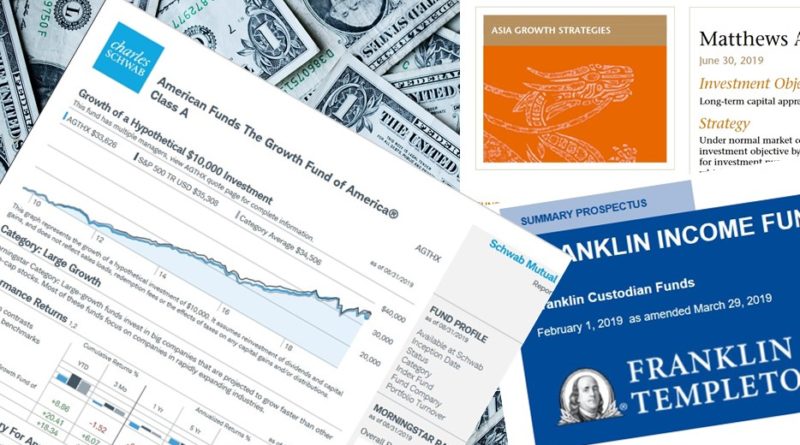Are Mutual Funds Right for You?
Preparing for retirement is better done the sooner you start. For many people mutual funds are a cost effective way to gain access to professional money management.
When should you invest?
Investing involves risk so there are steps everyone should take before they invest. The first thing anyone should do is to establish a budget. You must live within your means. The very first thing on your budget should be 10% of your income going to savings. If you have not already established your emergency fund, do that next. Set aside six months of expenses. You should use a stable account that doesn’t have the volatility of stocks and bonds. Use a checking account, savings account or money market. You won’t make much interest but you won’t expose yourself to market risk. An emergency fund will save you if something goes wrong and you need money at a time when your mutual funds are down in value.
To make your long term money grow it is important that you shelter the earnings from taxes. You’ll find many options for tax deferred savings right at your fingertips. Common tax deferred accounts are IRAs (Individual Retirement Accounts) and 401(k) plans offered by your employer and SEP-IRA (Simplified Employee Pension) which is an easy way to shelter your earnings from self-employment, even a part-time business that you own. Some of the above have a Roth version, named for Senator William Roth. Under the Roth version, contributions are not tax deferred, but earnings grow tax deferred and if held past age 59 ½ earning can be accessed tax free. Depending on age, the Roth version may be the better idea.
Your employer’s 401(k) plan will have a short list of mutual funds from which you can choose. It’s not always possible to build a complete asset allocation with just this short list and some funds offered may not be the best performers in their peer group or may have high expenses. When structuring your asset allocation, you may find yourself underweighting an asset class in one account and underweighting in another to achieve the best balance with the funds available to you.
Fund Objectives
A fund’s objective is described in its prospectus. An objective lays out what type securities it will buy what mix it will have, what distributions it will pay and so forth. Mutual fund management teams usually stay invested regardless of market conditions. It is up to you or your advisor to determine if you should be in the market.
The following definitions are but a few examples and come from the Investment Company Institute. Capital appreciation funds seek growth of capital; dividends are not a primary consideration, Growth funds invest primarily in common stock of growth companies, which are those that exhibit signs of above-average growth, even if the share price is high relative to earnings/intrinsic value, Investment Grade Bond funds seek current income by investing primarily in investment grade debt securities.
Your portfolio should have a reasonable mix of funds with different objectives to create diversified asset allocation. Over-weighting in funds with similar objectives like Capital Appreciation, Growth and
Domestic Equity would not be considered diversified because all three are similar. A better example of
diversification would be Growth Stock, Value Stock and Government Bond. Growth and Value stocks
have a history of negative correlation, meaning that when one goes up the other goes down. Stocks and
bonds have the same negative correlation history.
With a well-diversified portfolio, the hope is that whatever market condition, business event or political
news that causes one part of the portfolio to go down will cause another to go up thereby creating
balance and smoothing out volatility.
Sales loads
The sales Charge is sometimes the most confusing thing about mutual funds. Many companies do not
charge an upfront sales charge but still charge fees of course. For companies that do assess a sales
charge there is an alphabet soup of share classes from which to choose. This sales charge is
compensation to the salesman offering the advice on what you should buy. Only you can decide if you
need to pay for this service.
Let’s examine these share classes first. Each one has a different sales charge structure. The most
common share classes are A, B and C shares. Class A shares have an upfront charge or a “load.” It is
included in the price the investor pays for the shares known as the Public Offering Price or POP. For
example, a global growth fund Class A has a load of 5.75%. If its POP is $28.72 per share then its NAV,
Net Asset Value, would be $27.07. That’s the value of each share in your account immediately after the
transaction.
Other common share classes are B and C which have no load but instead charge a CDSC, Contingent
Deferred Sales Charge starting as high as 5% for Class B shares but decreasing per year until it reaches
0%. B shares are becoming less and less available since C shares have come available. Class C usually
charges a CDSC starting at 1%.
In addition to the sales load of Class A shares many funds also assesses a 12B-1 fee, named for the
Investment Company Act of 1940 section covering it. This fund example charges 25 bps (basis points)
per year or 0.25% which is deducted from the fund to cover its marketing expenses. This of course,
reduces the NAV by 0.25%. Both B and C shares usually charge a 12B-1 fee of 1% which can really put a
drag on return over the years.
Many fund companies offer various other share classes for specific situations like Class I Shares or
Institutional Shares which are common in wrap accounts and R Shares in 401(k) plans. These share
classes have lower loads or CDSCs if any.
If you require the advice of an investment salesperson, you will most likely pay a load. To keep your
overall cost down match your share class with your time horizon. In the first few pages of the
prospectus you should find a clear example of your total cost over different time periods. You should
find that the total cost of ownership of Class A shares are higher in the early years and Class C in the
later years. Read the prospectus for more information.
After the above explanation I am pleased to tell you that there are many funds that have no upfront
load or CDSC. These are called “no-load” funds. All of your money goes to the purchase of shares and
none to sales charges or commissions. With these you must do your own homework and make your
own decisions. People who are experienced and knowledgeable on investing benefit from no-load
funds. Those who are not can suffer some awkward circumstances from ill-informed decisions. Only
you can decide if you are willing to do the homework or if you are better to pay someone to make your
decisions remembering that they may have their own agenda.
Even with no upfront load, some funds may have a 12B-1 fee and/or “other” fees. You will find such
disclosed in the prospectus.
Expense Ratio
Regardless of whether a load or no-load mutual fund is right for you, all fund managers are
compensated for managing the assets. The fund pays a small percentage each year to the management
team. In addition the fund has other expenses. All of these fees combined are known as the Expense
Ratio. There is no significant difference in the expense ratios because of load or no-load status.
Expense ratios have consistently fallen over the past two decades as investors have sought out lower
cost funds. Recent reports show average expense ratios of equity funds at 0.63 or 63 cents annually for
every $100 invested. Bond funds and passive funds will cost less while global and small cap funds will
often cost more.
Rankings, Ratings and Advertisements
Where mutual funds rank compared to their peer group can be helpful but can be misleading if you
don’t understand how the system works. Be cautious of mutual funds that tout themselves as #1 in a
sector. Sometimes that means the fund went up in value more over the past year than its peers. What
are the chances that it will repeat? You should evaluate the fund based on a three or five year average.
For a fund that has performed well in longer time frames, you’ll also want to evaluate if the same
management team that turned in those results is still in place. The best evaluation, in my opinion, is
whether the fund’s return was better than its risk. Does the fund consistently have an above average
return with a below average risk, for example. Such profiles usually indicate capable managers.
As with any investment, do your homework, understand your investment and monitor its progress.





Hey! I just wanted to ask if you ever have any problems with hackers? My last blog (wordpress) was hacked and I ended up losing months of hard work due to no backup. Do you have any solutions to stop hackers?
Excellent question. Most web hosting companies provide some type service to block hackers. Check with your service provider to see what options can implemented on the server platform you use.
This design is wicked! You definitely know how to keep a reader amused. Between your wit and your videos, I was almost moved to start my own blog (well, almost…HaHa!) Wonderful job. I really loved what you had to say, and more than that, how you presented it. Too cool!
Thanks, Sam. You should start your own blog, too. Let me know when you do.
Greetings! This is my first comment here so I just wanted to give a quick shout out and say I genuinely enjoy reading through your posts. Can you recommend any other blogs/websites/forums that cover the same topics? Appreciate it!
Glad you enjoy the blog. I have over 30 years experience and have become an expert. Other blogs hire me to write their content. I suggest you subscribe here. Thanks
Hey! Quick question that’s completely off topic. Do you know how to make your site mobile friendly? My web site looks weird when browsing from my iphone. I’m trying to find a theme or plugin that might be able to correct this problem. If you have any suggestions, please share. Many thanks!
Go to this site to have a mobile friendly site. Click here.
My coder is trying to convince me to move to .net from PHP. I have always disliked the idea because of the expenses. But he’s tryiong none the less. I’ve been using Movable-type on a variety of websites for about a year and am concerned about switching to another platform. I have heard fantastic things about blogengine.net. Is there a way I can transfer all my wordpress posts into it? Any help would be greatly appreciated!
Visit this site for help with platform selection and moving your wordpress posts to new platform. Click here.
I love your blog.. very nice colors & theme. Did you create this website yourself or did you hire someone to do it for you? Plz answer back as I’m looking to create my own blog and would like to know where u got this from. thanks
Thanks. You can get this type blog at https://jefferythomas.me. Send a message on the ‘contact’ page and make sure you get a deep discount.
Thank you. You can have a blog and website created at a fair price by clicking here.
I quite like reading through a post that will make people think.
Thanks. Glad you enjoyed it.
Fabulous, what a website it is! This blog presents useful facts to us, keep it up.
We stumbled over here from a different web page and thought I should check things out.
Really appreciate you sharing this blog article. Will read on…
I appreciate, cause I discovered just what I was having a look for.
You’ve ended my four day lengthy hunt! God Bless you man. Have a nice
day. Bye
I would like to express my affection for your kind-heartedness in support of men and women that actually need assistance with this one issue. Your special commitment to getting the solution up and down appeared to be amazingly advantageous and has continuously made workers like me to achieve their pursuits. The insightful key points signifies so much to me and substantially more to my peers. Thanks a lot; from all of us.
You’re welcome. Glad you find it helpful.
I must point out my passion for your generosity giving support to individuals who actually need help on this particular subject. Your special commitment to passing the solution all-around had become amazingly invaluable and have consistently helped most people like me to attain their targets. Your new warm and friendly report entails a lot to me and somewhat more to my fellow workers. Warm regards; from all of us.
Thank you. Glad to help.